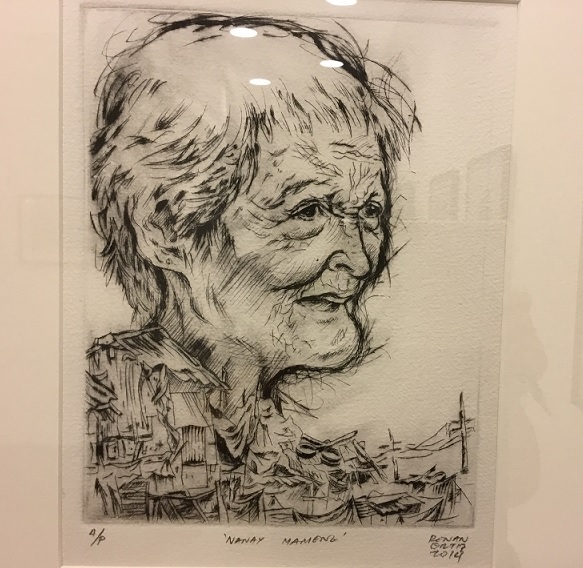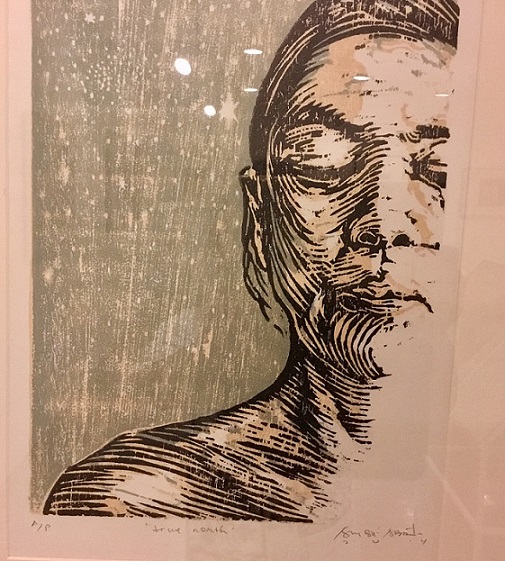A cornucopia of Philippine prints is on display at the Cultural Center of the Philippines in celebration of the 50th anniversary of the Association of Pinoyprintmakers, formerly known as Philippine Association of Printmakers. With prints made by mostly established artists, it is a veritable roll call of who’s who in Philippine contemporary art. Entitled Tirada 50 Years of Philippine Printmaking1968-2018, the exhibition runs until July 15, 2018.
Tirada features 173 prints, made by 140 artists listed in its brochure, including catalogues, posters, and photographs through the years.It is curated by Patrick D. Flores, professor of art studies at the University of the Philippines and recently appointed as the artistic director of Singapore Biennale 2019, Asia’s largest contemporary art show.
Basically, printmaking is a process that uses a variety of methods to transfer ink, colors, designs, patterns, or even text from one surface to another, usually paper. Known as fine prints, they are considered as original works of art, even if they can be produced in multiples.

Renan Ortiz’s Nanay Mameng
History: From catechism to cartography
It was the Spaniards who brought the first printing press in the country and the religious orders (Dominicans, Franciscans and Jesuits) printed prayer books and inexpensive prints of religious images, usually the Virgin Mary, Jesus Christ, or the saints, known as estampas or estampitas, used to propagate the Roman Catholic faith.
In cartography, the 1734 map drawn by Fr. Pedro Murillo Velarde SJ (1696-1753), A Hydrographical and Chorographical Chart of the Philippine Islands is considered as the first and the most important scientific map of the Philippines, engraved by Nicolas de la Cruz Bagay (1701-1771). Popularly known as the “the mother of all maps,” it was used by the Philippines to win an international ruling at the Hague against China’s territorial encroachments.
Tirada!
In printmaking lingo, tirada means “to strike” or “to pull off or to pull out” a piece of work in a series of multiples. It also means “effort and labor.”
Entering the main gallery, works made by the pioneers of printmaking greet the viewer. Two black-and-white prints of Manuel Rodriguez Sr. are on display: an intaglio, Dance of the Fire Birds, AC (2014) and an etching on paper, Interlude (1967).
Manuel Rodriguez Sr. (1912-2017), known as the Father of Philippine Printmaking, is one of the pioneers of printmaking in the country who studied at the Pratt Graphics Center in New York. By 1968, he had founded the Philippine Association of Printmakers.
Three colored woodcuts from Rodolfo Paras-Perez (1934-2011), another early advocate of printmaking, are on display, namely Man on Stake, Kiss, and Lovers, from his Florante at Laura Folio of 27 woodcut prints (1977).
The prints, dominated by figurative style with a mix of abstract works, deal with a variety of subject matter: nature, history, portraits, landscapes, emotions, poverty, freedom, protest and resistance.
Walking through the exhibition, one can see easily the wide range of practices and styles, using the flexibility of the medium in woodcut, etching, engraving, or lithography. Hybrid practices abound with a combination of drypoint, aquatint, or digital prints with rubber-stamped elements or hand-painted watercolor.

Ambie Abano’s True North
Ambie Abaño (b. 1967) shows her mastery of the woodcut in True North with one of her favorite subject, the powerful face of a woman, in sharp and decisive lines exuding grace and strength.
One of the youngest artist in the exhibition is Henrielle Pagkaliwangan (b. 1994) whose work is a stunning panorama of a Manila Bay view with buildings in the horizon, in three colors and in single editions: Umaga, Dapithapon, and Gabi (2018), all in monotype and drypoint on paper.
Some unconventional materials include a cotton dress, recycled aluminum plates, wooden clogs with rubbercut printed soles, and a sandbox containing footprints on the sand, a tribute to Raymond Albano (1947-1985) and his work, Step on the Sand and Make Footprints that received an Honorable Mention in the Ninth International Biennial of Prints in Tokyo, 1974.
Long live the print!
Reaffirming the potential of printmaking in contemporary art, the exhibition examines the ways in which Filipino artists have reconfigured the medium, depending on their subject matter and aesthetic visions.
The exhibition raises questions of what it means to be a Filipino artist in the borderless world of printmaking. Aside from artistry, the exhibition valorizes the active involvement of the artist who is “responsible for the painstaking road to the process, from designing to inking, and finally to printing” — an analogue challenge posed by the Association of Pinoyprintmakers in this age of digital technology.